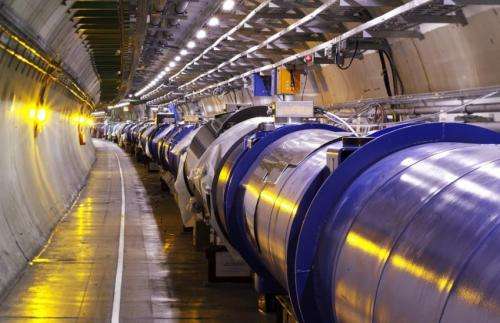April 14, 2014 report
Last Week's Best—Quantum mechanics breakthrough, 3-D printed human heart, and paraplegia therapy

(Phys.org) —Hello readers—we'd like to try something new here at Phys.org and Medical Xpress: offer a weekly summary every Monday highlighting what we feel are the most important stories of the past week. Here, then, is the first of what we hope will be a successful series:
One of the week's biggest stories was the Large Hadron Collider team announcing a restart after shutting down this past February for repairs and updates to many of its systems.
It's also been a very big week for the biological sciences. A breakthrough therapy has allowed four paraplegic men to voluntarily move their legs. Funded by the Christopher Reeve Foundation and NIH, the therapy is based on an implanted epidural stimulator that delivers electric current to the lower spine. Thus far, it has allowed for movement of hips, ankles and toes. And speaking of rejuvenation, researchers at Edinburgh University in Scotland have rejuvenated a living organ for the first time—they increased levels of a protein that controls gene switching in a mouse, resulting in the rejuvenation of a thymus that had deteriorated due to age—afterward, the organ was once again able to produce T-cells.
Also making big news this week, scientists confirmed that a scroll that mentions Jesus's wife is ancient. After studying the ancient papyrus sheet, a team of researchers working in the U.S. concluded that it was not a forgery, a finding that is likely to cause a stir in the Christian community as it suggests that a woman played a far more important role in the life of Jesus than has been mentioned in the New Testament.
A team at the University of Tokyo has found a way to control individual neurons in the brain of a mouse by sending reward signals to its hypothalamus, one of the brain's pleasure centers. In so doing, the researchers discovered that they were able to get the mouse to turn on individual neurons in its own hippocampus.
Elsewhere, another team of researchers at NYU Langone Medical Center has found that memory accuracy and strength can be manipulated during sleep by exposing rats to certain odors while they snooze. The hope is that such therapy may forestall certain neurodegenerative disorders.
Also, there is news out of the University of Louisville as scientists try 3-D printing to build a human heart—they've already printed out small veins and heart valves. The research team believes they may be able to print all of the major heart parts, ready for assembly, in as little as five years.
And at the Georgia Institute of Technology, a new study explains evolution of duplicate genes—researchers there have shown explicitly how the processes of DNA methylation and duplicate gene evolution are related and how some duplicate genes could have escaped elimination long ago from the genome, leading to the genetic innovation we see now in modern life.
In other news, physicists created lightning in a race to develop a quantum technology microchip. Physicists working in England have developed a new microchip that can hold the voltage equivalent of a micron-scale lightning strike—it could very well prove to be the key for developing the next generation of super-fast quantum computers. And finally, scientists discovered a novel way to make ethanol without corn or other plants—they've used a metal catalyst that can produce ethanol from carbon monoxide at room temperature and pressure. If it can be scaled up and shown to be cost effective, the technique could prove to be a true game changer.
Realizing that people are busy, our weekly recap will highlight some of the most important work we've covered, in case you missed it the first time. As always, please feel free to let us know your thoughts.
© 2014 Phys.org





















